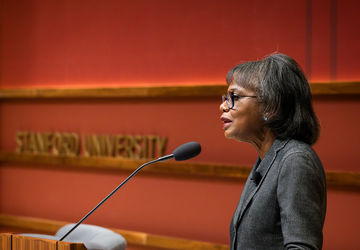Constitutional scholar identifies connections among suffrage, abolition, and gender in modern U.S. election law

The 14th and 19th amendments have long been central to legal scholarship on issues of gender and women’s rights. Questions about gender, politics, and the democratic process have become even more salient in the wake of the Supreme Court’s June 2022 overturning Roe vs. Wade. Shortly after arriving back at Stanford from the U.S. Department of Justice, legal scholar Pamela S. Karlan began work on a chapter on gender and election law for The Oxford Handbook of American Election Law, forthcoming 2024. Karlan shared her work in a recent presentation as part of the Clayman Institute Faculty Research Fellows program.
Karlan explains that gender has had profound effects on U.S. election law, and in ways bound to the legacy of American slavery. Gender is mentioned twice in the U.S. Constitution: first in Section II of the 14th Amendment, which penalizes states that abridge “male” citizens’ voting rights, after Section I extends citizenship to the formerly enslaved; and then in the 19th Amendment, which declares the vote “shall not be denied or abridged by the United States or by any state on account of sex.” Between these two amendments, Karlan demonstrates, a complex story emerges about race and gender in the making of U.S. electoral law. Far from being a straight line toward universal suffrage, this research shows that voting access has waxed and waned across the centuries: always restricting the franchise based on popular opinion of who is fit to vote, and through a history of advocacy and litigation, always invested in a campaign for self-possession and bodily autonomy.
Far from being a straight line toward universal suffrage, this research shows that voting access has waxed and waned across the centuries: always restricting the franchise based on popular opinion of who is fit to vote, and through a history of advocacy and litigation, always invested in a campaign for self-possession and bodily autonomy.
She began by describing how New Jersey’s revolutionary-era state constitution made no gender specifications, meaning that some form of women’s suffrage existed in the United States at the moment of its founding. By New Jersey law, any citizen owning £50 of land (approx. $11,000 in modern U.S. dollars) was entitled to vote in 1776, and while this changed nothing for married women (coverture law meant such property was held only by their husbands) it did grant the vote to land-owning widows. Voting restrictions only became identity-based when property restrictions fell out of fashion––a shift brought about in part by a commitment to enfranchise men who had served as soldiers in the Revolutionary War. The elimination of these restrictions inspired new anxieties over social power, who would wield it, and what they would do with it, which is how race and sex/gender came to be specified in election law.
The genuine movement for women’s suffrage emerged from the abolitionist movement focused on the enslavement of Black people. Founding suffragists Elizabeth Cady Stanton and Lucretia Mott first resolved to secure the vote after attending the 1840 World’s Anti-Slavery Convention in London, where as women they were barred from the convention floor. It was from this resolution that they organized the 1848 Seneca Falls convention, launching the women’s suffrage movement as a powerful allied force to the fight for abolition. Despite this close sympathy, however, the struggle over Black enfranchisement after the Civil War fractured the suffrage movement.
Language addressing citizenship and suffrage at first had been included in the 13th Amendment, before being contested by suffragists, dropped, then recovered in the 14th and made explicit in the 15th. This language established birthright citizenship and repudiated the 3/5th Compromise, to require congressional representation be apportioned according to “the whole number of persons in each state.” But the mechanism the amendment’s framers installed to ensure that states did not disenfranchise the freedmen stripped states of those apportioned representatives only if they restricted the voting eligibility of their “male” citizens. Suffragists protested the way this protection was limited, stressing that the language would codify women’s exclusion from the franchise as a matter of constitutional law. Some of them even opposed ratification of the amendment because it did not secure voting rights for women.
Those advocates were not incorrect about the constitutional significance of the phrasing. Shortly after the 13th, 14th, and 15th Amendments passed, the Supreme Court ruled on an 1874 case brought by the suffragist Virginia Minor, asserting her right to vote in the 1872 presidential election. The court’s unanimous ruling addressed “nearly every angle of constitutional analysis,” Karlan said, explaining its usefulness for her courses in the Stanford School of Law. As lower courts had previously ruled with state constitutions, originalist readings gave no indication that the men who wrote these laws intended that their power be shared with women. And as suffragists had anticipated, a structuralist reading of the 14th Amendment makes it very clear: if penalties only specify male disenfranchisement, they imply that female disenfranchisement is to be permitted or even assured. Virginia Minor would not be allowed to vote.
States’ ability to exclude women ended with the ratification of the 19th Amendment in 1920. In 1922, the Supreme Court upheld the amendment’s reach in Leser v. Garnett, where a Maryland man challenged the registration of women. Observing that the 19th Amendment is “in character and phraseology precisely similar” to the 15th Amendment, and that “for each the same method of adoption was pursued,” the court ruled that “one cannot be valid and the other invalid.” Karlan explained that there has been comparatively little litigation around the 19th amendment since this ruling.
In their near overlap, the Dobbs ruling and the centennial celebration of the 19th Amendment’s passage have sparked “a recent efflorescence of scholarship” on these legal histories. The relationships they illustrate between voting rights, civil rights, and the simple claim to bodily autonomy can inform continued advocacy for enfranchisement today. Gender does not only pertain to election law in terms of who has been allowed to vote, after all, but also in terms of who has been elected. Karlan explains that gendered expansion of the franchise has not come close to equalizing women’s representation in elected office in the United States, and experimentation with different electoral models has shown the potential to close this gap. There can be little question that women’s representation in elected office will be consequential for the fight for reproductive freedom in the years to come.


